
There are many ways to reach a goal- not just one. For example, if someone asks you to fold a piece of paper (a seemingly simple goal), there are many ways to do it- not just one. And they all get that paper folded!
Differentiating skills is so important because some children may understand one way, while it will click with others a different way. Plus- they are all receiving the lesson at very different stages of their writing ability, so what one may pick up, may fly right over another's head at that time.
Analogies work well with me. That's how I "get" things. So here are my thoughts on writing. Lots of us have "canned" programs. That's fine. It gives us a good base with skills we need to teach. But to me, it's sort of like canned soup. It's just that- fine. My thoughts are that restaurants don't hire professional chefs to pour out a can of soup, just like schools don't hire professional teachers to read guide books verbatim and pour out a canned program.
Restaurants hire and trust their chefs to create the best soup possible from the best ingredients. Schools should feel the same. Teachers should be given great leadership, a variety of PD opportunities, time to share real ideas that work, and trust that they will deliver the best finished product they can! We shouldn't have to close our doors and do what we know works. We should be proud that there may be ideas to help others. Lots of time, the trust isn't there from leaders, and they worry that if a program isn't followed by the book, that teachers won't teach what they need to. This makes me sad, because it undercuts the trust in professional teachers to want the best for their students. We can start with the canned soup, but each of us have special ingredients to add to make it better. (Think - Chopped or Semi-Homemade!)
And teachers- don't give recipes and leave out one ingredient when you share. When you share ideas with your fellow teachers, you are helping not only your students, but hundreds of other students who may benefit from that idea. Isn't that our goal? That we all have the tastiest, most delicious smorgasbord of learning?
That's my "Soup Box" for the day.
Over the years, I've found some easy ways that work for my kids to help reinforce and teach some of these parts of writing. I thought maybe you could use some, too!

TITLES
Then, I show some papers with titles on them so the children tell me what the book will be about.
Next, I show some real books and we decide what those are about. Donald Crews' books work well for this.
Then, I have some papers with good titles, and some with NOT good titles for the children to see. They explain to me why they are or are not good titles.
The children can turn and talk to explain that a title is a name of a book, just like people, animals, and streets have names.
This idea also helps when you get to using capital letters- because names always begin with a capital letter. Names of people, pets, streets, months, and BOOKS!
STAYING ON TOPIC and WRITING ACROSS PAGES (Touch and Talk)
When we begin writing books, one important point for students to understand is how to stay on topic. This is tricky when you're five and your mind is going in lots of directions.
Since we're also introducing the idea of writing across pages, I model this a lot. I sit with a blank book (cover and three pages) and think out loud about what I'll write about. I may choose, "Cats." My title will be Cats because that is what my book will be about. I will remind the children that my book will be all about cats. That is my topic or idea. As I touch and talk, I'll say the title and my author name on the cover, "Cats, by Mrs. Kisloski." "What is my book going to be about?" Then I'll go to page one. "Cats can run." Page two- "Cats can play." Page three- "I like pickles on my hamburger."
The children love to point out my mistakes so this is right up their alley! The sillier the page that doesn't fit in, the better.
Then, I'll try again. Maybe the page that doesn't fit is in the middle. "Snowmen, by Mrs. Kisloski."
"Snowmen have a head." "My sister pinched me this morning." Snowmen have buttons."
I'll ask, "What page didn't belong in my story?" "Why?"
You can tie this into "What doesn't belong?" games or paper activities to reinforce the concept of one idea per book.

AUTHENTIC WRITING
I love fitting in authentic writing opportunities any chance I get. The week before Halloween, each day I had the children write one sentence, focusing on all of the conventions (beginning with a capital letter, leaving spaces between words, writing sight words, rereading as they wrote to be sure not to leave out any words, forming letters correctly, printing neatly, and using ending punctuation). There's SO much to remember when you are learning to write. And I think it's important for children to see how correct sentences should look and to see that they can actually write them correctly!Each sentence had a fun surprise. One day they wrote "I like my_____." and then I gave them a spider ring. They heard the sounds they could in "spider ring" and could look at their ring to draw the picture in the picture box part of the paper.
The next day, they wrote "We see the _____." This day, I gave them each a bat ring. They had to hear the sounds in "bat," then draw a bat in the picture box.
Another day was a question- "Do you like ______?" I gave them candy corn for this one. They heard "can" in "candy" and I was so proud of them! In the picture box, they drew themselves with a speech bubble saying "yes" or "no" to answer the question.
Since we worked on the letter Ll this week, I gave each child a pair of lovely lips. They had to write "Look at my" and then I gave them the surprise and they had to hear the sounds in that word "lips." We took a picture of everyone in their lovely lips to send home.
You can use anything and everything to make writing sentences fun!
As the year progresses, I use writing prompts to go with books we read all the time. I have two packets of them with QR codes to go with the prompts, and one packet of only writing prompts to go with stories. My kids love them. The QR codes are also on the writing prompts so the children can listen to the stories again at home all they want.
This one I use for Author Studies because it has 103 stories featuring 8 different authors.
This is one of my favorite pieces of authentic writing for the week. One of my sweeties has had a walking cast on her foot for a few weeks and was finally going to get it off, so another friend gave her this note. You should have seen them both beaming!
I have my Primary Writing Prezi up every day during Writer's Workshop so I can zoom in on reminders about topics, editing, or conventions.
I use it to teach concepts I want the children to know- and to reinforce concepts as a mid lesson teaching point. It includes all sorts of links, anchor charts, and videos to go along with different types of writing.
Prezis are easy to make- and are a great way to find some extra wall space in the classroom! You can add any pictures or charts you'd like. I don't have lots of wall space for anchor charts, so I also leave different anchor charts depending on what area we are working on, as the children write. It's great to be able to leave up the alphabet anchor chart on the big TV, or the sight words to use as another word wall.
I use it to teach concepts I want the children to know- and to reinforce concepts as a mid lesson teaching point. It includes all sorts of links, anchor charts, and videos to go along with different types of writing.
Prezis are easy to make- and are a great way to find some extra wall space in the classroom! You can add any pictures or charts you'd like. I don't have lots of wall space for anchor charts, so I also leave different anchor charts depending on what area we are working on, as the children write. It's great to be able to leave up the alphabet anchor chart on the big TV, or the sight words to use as another word wall.
I find the kids writing folders really get in their way as they are writing books. Trying to flip through and find an alphabet chart is hard for some of my kids who have a hard time focusing on one thing, so having a big alphabet chart up as another place to link letters is really helpful.
Of course a "Be Brave" section is on this Prezi, I am always telling my children to BE BRAVE when they read and write. Be brave and try to hear as many sounds as you can, and get those words down on paper. Be brave and try to draw something you think you can't draw! Sometimes we just need to have a BRAVE anchor chart up to remind us. OR we need to dance to the Brave song by Sara Bareilles.
Here are some great books to share with your class about being BRAVE.
If you haven't seen Courage by Bernard Waber, it is such a wonderful book. It's great for conversations about being brave, and how courage is being brave for both big and small things. Here are some pictures from the book:
This is NOT how to be brave. But how cute are those penguins?
Here is my Reading Prezi that I use each day for reading. I use it the same way- to reinforce concepts, as a mid-lesson teaching point, and to leave up anchor charts as the children read.
Or I can zoom in on a specific anchor chart to leave up as a reminder or mid-lesson teaching point.
We are constantly reviewing reading strategies!


from Amazon:
All week long, a boy and his father look forward to their Friday ritual—breakfast at their favorite diner. The leisurely walk through the neighborhood is just as good as the pancakes at the end.
This makes the book even more special:
Author Dan Yaccarino Talks About His Inspiration for Every Friday I guess the Friday breakfasts came about because like most dads, I sometimes didn't feel like I saw my son enough. Some weeks, our Friday breakfasts were the only time he and I had to talk or just share some time together.
I look back on when we started what became our little tradition. He was in preschool and had to start sharing his mom and dad with a new little sister. I wanted him to have some time when he didn't have to put up with a crying baby who yanked his ears, which he patiently tolerated. He and I soon looked forward to Fridays and the diner's owner, Nick, as well as a variety of regulars, warmly greeting us. To their continued astonishment, he consumed an entire adult-size order of pancakes and a side of bacon, of which I was very proud. I have fond memories of us watching people trudging through the snow and rain as he and I were cozily nestled in a booth, a little oasis from the outside world. As much as we loved Nick’s Diner, I think we both preferred the small journey we took each week to get there. It may have been a mere four blocks, but it was full of adventure: greeting familiar faces, window shopping and monitoring the progress of a building on the corner going up story by story. Nick's Diner has since closed, so our breakfasts have been relocated to another and like that building, my son is now tall and strong. I look back on his wonder of the world and fascination of even the smallest things. Even though it was only a few years ago, life seemed a bit less complicated. My hope for Every Friday is for dads, and moms, to set aside some time to be with their children. It doesn't have to be breakfast on Friday, but it should be some time that they can count on to be with just you. And perhaps many years from now, they will carry on the tradition with their own children.
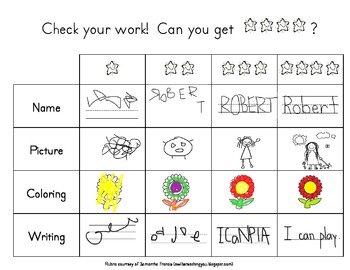 This fabulous packet from Amy Morgan is perfect to show the children how adding details to writing adds so much to a story. I got more excited as I saw and read more sentences on each page, and so did the children. We had so much fun with this. We counted the sentences. We found the periods, and noticed that sentences don't just end at the end of a line but at the end of a complete thought. We talked about how much more interesting the illustrations were with details and color, too.
This fabulous packet from Amy Morgan is perfect to show the children how adding details to writing adds so much to a story. I got more excited as I saw and read more sentences on each page, and so did the children. We had so much fun with this. We counted the sentences. We found the periods, and noticed that sentences don't just end at the end of a line but at the end of a complete thought. We talked about how much more interesting the illustrations were with details and color, too.
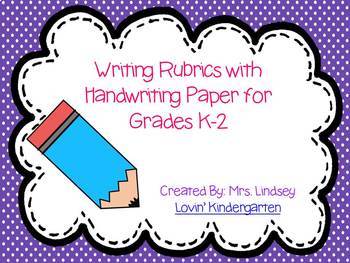

Tanya Dwyer shared such a great Mini-Book Writing and Rubric with a fairy tale and a Star Wars mini book writing activity. This looks like so much fun to use. The kids will love it.
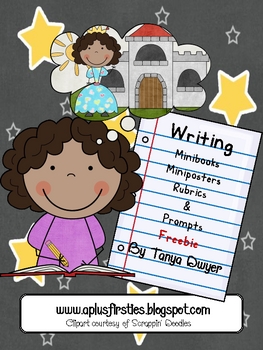
If we are Partner Reading or talking about books, I can talk about those anchor charts.
Or I can zoom in on a specific anchor chart to leave up as a reminder or mid-lesson teaching point.
We are constantly reviewing reading strategies!

HERE is a link to a packet for both Prezis.

Finally, I wanted to share some fabulous FREEBIES from TpT that I found and have loved using with my class during Writer's Workshop. I have shared most of these before, but sometimes I forget about them, so I thought it would be good to remember some of these great things!
My children always need some more practice with conventions (well- of course, because they are five...). The children really enjoy and seem to understand writing small moment stories, and these are great for getting ideas down on paper, and for helping the children focus on one or two important conventions- like using a capital letter to begin a sentence or using ending punctuation.
Every Friday is my favorite small moment mentor text. Kathy Griffin introduced me to it earlier this year, and I just love it.
It is a sweet, simply written story. The children really see that one memory can turn into a story. Here are some pages from the book.
from Amazon:
All week long, a boy and his father look forward to their Friday ritual—breakfast at their favorite diner. The leisurely walk through the neighborhood is just as good as the pancakes at the end.
This makes the book even more special:
Author Dan Yaccarino Talks About His Inspiration for Every Friday I guess the Friday breakfasts came about because like most dads, I sometimes didn't feel like I saw my son enough. Some weeks, our Friday breakfasts were the only time he and I had to talk or just share some time together.
I look back on when we started what became our little tradition. He was in preschool and had to start sharing his mom and dad with a new little sister. I wanted him to have some time when he didn't have to put up with a crying baby who yanked his ears, which he patiently tolerated. He and I soon looked forward to Fridays and the diner's owner, Nick, as well as a variety of regulars, warmly greeting us. To their continued astonishment, he consumed an entire adult-size order of pancakes and a side of bacon, of which I was very proud. I have fond memories of us watching people trudging through the snow and rain as he and I were cozily nestled in a booth, a little oasis from the outside world. As much as we loved Nick’s Diner, I think we both preferred the small journey we took each week to get there. It may have been a mere four blocks, but it was full of adventure: greeting familiar faces, window shopping and monitoring the progress of a building on the corner going up story by story. Nick's Diner has since closed, so our breakfasts have been relocated to another and like that building, my son is now tall and strong. I look back on his wonder of the world and fascination of even the smallest things. Even though it was only a few years ago, life seemed a bit less complicated. My hope for Every Friday is for dads, and moms, to set aside some time to be with their children. It doesn't have to be breakfast on Friday, but it should be some time that they can count on to be with just you. And perhaps many years from now, they will carry on the tradition with their own children.
We practice together writing sentences in whole group guided writing lessons. We review beginning with a capital letter and not putting random capital letters in the rest of the sentence, leaving spaces between words, writing neatly, rereading to be sure no words are left out, and ending with a punctuation mark, just like I'm sure all of you do!
Krazy in Kindergarten has a great Spaces Rubric that helps the children see what spaces should look like.
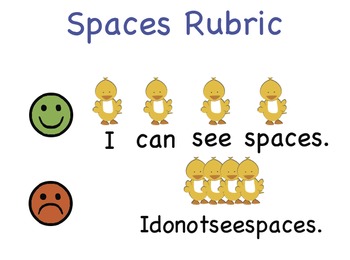
Krazy in Kindergarten has a great Spaces Rubric that helps the children see what spaces should look like.

I LOVE Samantha Francis' 4-Star Kindergarten Rubric. I printed out and laminated one of these for each of my students to use. It is a wonderful visual for the children. They "get" it. This was a great mini lesson and is a great review before I send them off to start writing, too. This is also a great one to share with parents so they know where we want the children to be in writing.

These are some writing packets with some great printable writing papers for the children to use. They have reminder rubrics right on the papers for the children.
Mrs. Lindsey has a great Writing Rubric K-2 Packet at her TPT store.
Lisa Sadler shared this journal page with editing at the bottom. It is easy for the children to use!
Karen Langdon shared a great Writing for Readers Packet of writing papers. Her reminder rubric has real photographs.
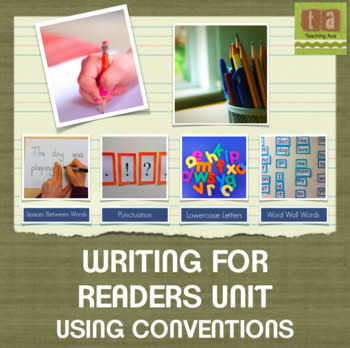


Thank you for stopping by! Have a great week!













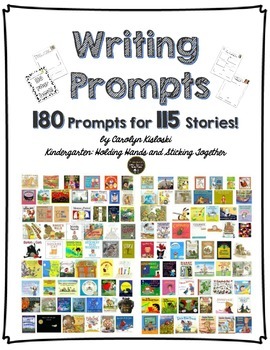



























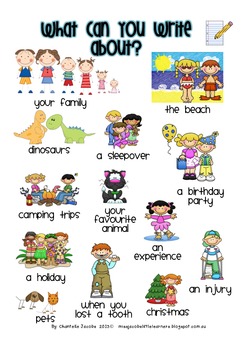

Oh My Gosh! You are a true gift to both students and teachers alike. Thank you for taking the time to post these ideas. I teach first grade, but many of my students would benefit from these lessons and ideas. You are wonderful!!!!!!!!!
ReplyDeleteJulie heyjbales@sbcglobal.net
Julie, thank you SO much for writing! You have no idea how that completely made my day! :) Have a wonderful weekend!
ReplyDeleteCarolyn
ReplyDeleteYou are so right about "canned" programs of any kid. Being allowed to use professional judgement and "best practice" makes a rich curriculum. There are so many resources available. You are a wonderful teacher to all students (I include myself because I am still learning)!
THANK YOU
Janet
Thank you so much for writing, Janet! I really appreciate it. I love when we all share what has really worked and helped up in the classroom- so hopefully it can help other children! :) Enjoy your extra hour this weekend!
DeleteLove the "soup" box! I fully agree! I will be sharing this post with the primary teachers I mentor. :)
ReplyDeleteThank you so much! And thank you for writing. Sometimes we just need to know it's OK to use ideas we like and we know work! :)
DeleteTo develop love of writing you have to be a really skillful teacher that will address the matter with full professionalism and creativity. To reinforce the kids’ involvement in the writing practice you should read a lot of information on the subject, perhaps browse the Net orfind essay writers online to ask for some advice. This post deserved my attention because of the level of motivation that the author has and wants to indulge her learners in the world of writing for them to develop their writing skills as soon as possible and be better prepared for their further learning at a college.
ReplyDelete